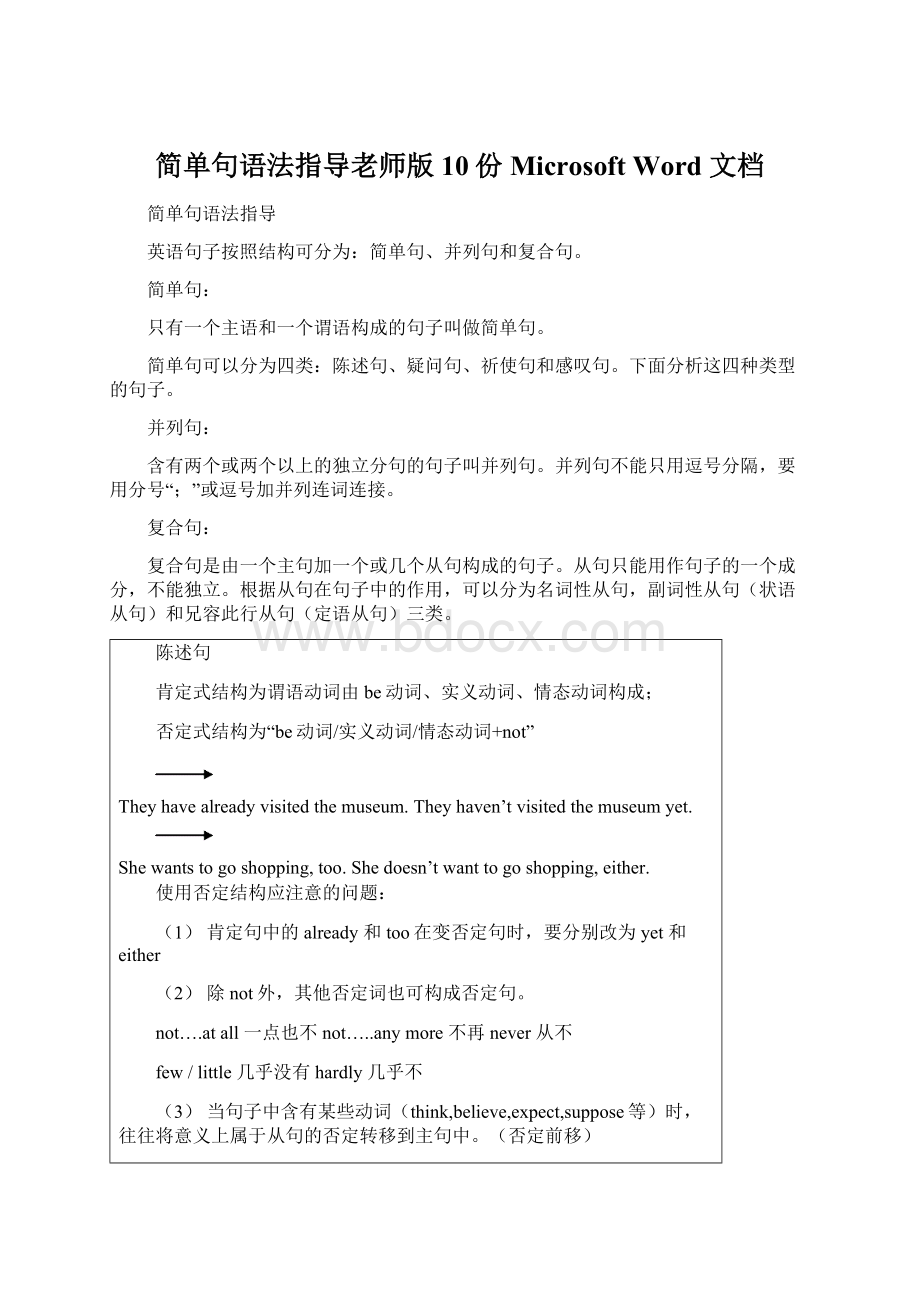简单句语法指导老师版10份 Microsoft Word 文档.docx
《简单句语法指导老师版10份 Microsoft Word 文档.docx》由会员分享,可在线阅读,更多相关《简单句语法指导老师版10份 Microsoft Word 文档.docx(16页珍藏版)》请在冰豆网上搜索。

简单句语法指导老师版10份MicrosoftWord文档
简单句语法指导
英语句子按照结构可分为:
简单句、并列句和复合句。
简单句:
只有一个主语和一个谓语构成的句子叫做简单句。
简单句可以分为四类:
陈述句、疑问句、祈使句和感叹句。
下面分析这四种类型的句子。
并列句:
含有两个或两个以上的独立分句的句子叫并列句。
并列句不能只用逗号分隔,要用分号“;”或逗号加并列连词连接。
复合句:
复合句是由一个主句加一个或几个从句构成的句子。
从句只能用作句子的一个成分,不能独立。
根据从句在句子中的作用,可以分为名词性从句,副词性从句(状语从句)和兄容此行从句(定语从句)三类。
陈述句
肯定式结构为谓语动词由be动词、实义动词、情态动词构成;
否定式结构为“be动词/实义动词/情态动词+not”
Theyhavealreadyvisitedthemuseum.Theyhaven’tvisitedthemuseumyet.
Shewantstogoshopping,too.Shedoesn’twanttogoshopping,either.
使用否定结构应注意的问题:
(1)肯定句中的already和too在变否定句时,要分别改为yet和either
(2)除not外,其他否定词也可构成否定句。
not….atall一点也不not…..anymore不再never从不
few/little几乎没有hardly几乎不
(3)当句子中含有某些动词(think,believe,expect,suppose等)时,往往将意义上属于从句的否定转移到主句中。
(否定前移)
Idon’tthinkthereisanyquickanswertothequestion.我认为这个问题不能很快就给出答案。
Idon’tbelievesuchlittleanimalscaneatsomanyinsects.
我认为这么小的动物吃不了这么多昆虫。
★注意:
英语中的部分否定以及全部否定
部分否定
全部肯定
all…..not;not….all
none
notboth…..;both….not
neither
notevery….;every….not
no+n.
notalways….
never
例句翻译:
Notallbirdscanfly.=Allbirdscannotfly.不是所有的鸟都会飞
Bothofthetwomathproblemsarenotverydifficult.
=Notbothofthetwomathproblemsareverydifficult.
并非两道数学题都难。
Noteverybookiseducative.=Everybookisnoteducative.
不是每本书都有教育意义的。
Heisnotalwayssosad.他并不是一直都这样悲伤。
Noneofuswasallowedtogothere.我们全都不让去那里
将下列句子变成全部否定:
Allofthemcandoit.Noneofthemcandoit.
Botharegood.Neitherisgood.
Everybodyknowsit.Nobodyknowsit.
Heisalwayslate.Heisneverlate.
疑问句:
疑问句用以提出问题。
按结构可分为一般疑问句、特殊疑问句、反义疑问句和选择疑问句。
1.一般疑问句常用“Yes”或者“No”来回答。
构成:
“Be动词+主语+表语….”或“助动词/情态动词+主语+谓语….”结构来表达。
AretheyfromFrance?
Yes,theyare./No,theyaren’t
Didshewritethisletter?
No,shedidn’t./Yes,shedid
Canyoutellmethewaytothestation?
Yes,Ican./No,Ican’t
2.否定疑问句
构成:
“Be动词/助动词/情态动词+not+主语…..?
”
Won’tyouhaveacupoftea?
(提出建议)
Haven’tyoureadthenewspaper?
(表示惊异)
注意:
对于否定形式的一般疑问句的回答要根据事实情况判断不要翻译成中文。
肯定回答用“Yes+肯定简略句”
否定回答用“No+否定简略句”
(2)反义疑问句的回答:
反义疑问句一般用yes或no回答,但要注意时态及人称代词的呼应。
特别注意在“前否后肯”的句子,要根据事实情况回答.
Eg.-------Heisn’tadoctor,ishe?
-------Yes,heis./No,heisn’t.
Eg.-----He’sadoctor,isn’the?
------Yes,heis./No,heisn’t.
(3)反义疑问句的注意事项:
a.句子中含have的反义疑问句
Hehashadsomethingtoeat,hasn’the?
Hehadashower,didn’the?
Hedoesn’thavemuchmoney,doeshe?
She had studied a few English songs by the end of last month,hadn’tshe?
Theyhadtoleaveearly.didn’tthey?
Wehavetogetupatfourtomorrow,don’twe?
陈述部分的谓语动词是have/hasto,表示“不得不”,反意部分的谓语动词常用do的适当形式
b.陈述部分是therebe结构时,附加问句仍用there.
Therewasalotoftraffic,wasn’tthere?
c.
陈述部分为肯定祈使句时,附加问句用willyou或won’tyou.
陈述部分为否定祈使句时,附加问句用willyou.
陈述部分是以Letme/us开头的祈使句时,附加问句用willyou.
陈述部分是以Let’s开头的祈使句时,附加问句用shallwe.
Lookattheblackboard,will/won’tyou?
Don’tmakeanynoise,willyou?
Letuswaitforyouinthereadingroom,willyou?
Let’sgotothecinema,shallwe?
d.陈述部分带有no,never,hardly,seldom,hardly,few,little等否定词时,附加问句用肯定形式。
若是带有否定词缀的派生词,如dislike,useless,unable,helpless等,则附加问句根据谓语动词而定。
TheyhardlywatchTVonschoolnights,dothey?
Heisneverlateforschool,ishe?
Itisimpossibletoforgetthepast,isn’tit?
It’sunfair,isn’tit?
e.陈述部分是主从复合句时,附加问句通常与主句一致。
注意:
若陈述部分主句的主语为第一人称,谓语动词为think,believe,suppose等后接宾语从句时,附加问句部分与宾语从句一致,且注意从句中的否定转移现象。
TheyallthinkthatChineseisveryimportant,don’tthey?
Hesaidhewouldcomeherethenextday,didn’the?
Webelieveshecandoitbetter,can’tshe?
Idon’tthinkhelikesplayingfootball,doeshe?
f.陈述部分的主语是指人的不定代词noone,everyone,someone,everybody等,强调全部时,其附加问句的主语用they;强调个体时,附加问句的主语用he.
Everyoneknowstheanswer,don’tthey?
人人都知道答案,是这样吧?
(强调整体)
Someoneisexpectingyou,isn’the?
有人在等你,是不是?
(强调个体)
g.陈述部分的主语是指物的不定代词everything,anything,something,nothing等时,附加问句的主语用it.
Everythinggoeswellwithyou,doesn’tit?
你一切顺利,是吧?
Nothinghappenedtohim,didit?
他没有遇上什么事,对吗?
注意;these,those作主语时,附加问句要用they.
Thesearenotbooks,arethey?
h.感叹句的反义疑问句
Whatafunnyman,isn’the?
Howcooltheweather,isn’tit?
How fast he runs,doesn’t he?
Howinterestingthebooks,aren’tthey?
5.选择疑问句
选择疑问句时用or连接询问的两部分,以供选择,答案必须是完整的句子或其省略式,不能用yes或no
-----Doyougotoworkbybusorbybike?
----Igotoworkbybus.(bybus)
祈使句
祈使句用来表达请求、命令、劝告等语气。
祈使句的谓语动词没有时态、数的变化。
1.第二人称作主语的祈使句用动词原形开头。
Getupquickly,oryouwillbelateforschool.
Pleasecomeandmeetmyfamily.
第一、三人称作主语的祈使句通常以let开头,否定形式在动词原形前加not.
Letushaveanothertry.
Let’snotsayanythingaboutit.
2.祈使句的否定形式
祈使句的否定形式一般在句首加don’t,有时也可用never.
Don’teatintheclassroom.
Neverjudgeapersonbylooks.
在回答具有否定意义的祈使句时,要注意分析上下文语境中所提供的条件.
例:
Don’tgoout,please.It’srainingheavilyoutside.
---->Yes,Iwill.Ihavetomeetmybrotherattheairport.不行,我得去机场接我弟弟.
感叹句
一般用what或how引导。
What修饰名词;how修饰形容词、副词、或句子
1.what引导的感叹句
what+a/an+形容词+单可数名词(+主语+谓语)!
What+名词性词组
What+形容词+不可数名词/复数可数名词(+主语+谓语)
Don’twaitforpeopletobefriendly,showthemwhatafriendlypersonyouare.
不要等待别人对你友好,让他们了解你是多么友好的人。
Whatinterestingbooksyou’veboughtus.
2.how引导的感叹句
How+形容词/副词(+主语+谓语)!
Howcleverthegirlis!
How+形容词+a/an+单数可数名词(+主语+谓语)Howcleveraboyheis!
How+主语+谓语Howtimeflies!
3.两种感叹句的互换
“How+形容词+a/an+单数可数名词(+主语+谓语)”形式的感叹句可以与
“what+a/an+形容词+单可数名词(+主语+谓语)!
”形式的感叹句互换,且意义不变。
HowlongawayitisfromBeijingtoNewYork!
=WhatalongwayitisfromBeijingtoNewYork.(注意两种感叹句互换时冠词的位置变化)
把下列各句改成感叹句:
1.Theyareverybeautifulflowers.
Whatbeautifulflowerstheyare!
Howbeautifultheflowersare!
2.Thewomanisverykind!
Howkindthewomanis!
Whatakindwoman!
3.We’rehavingafineday.
Whatafinedaywe’rehaving!
4.Peterjumpshigh!
HowhighPeterjumps!
5.HewritesEnglishwell.HowwellhewritesEnglish!
并列句
含有两个或两个以上的独立分局的句子叫并列句。
并列句不能只用逗号分隔,要用分号“;”或逗号加并列连词连接。
常用的单个词的并列连词有and;but;or;so等
单个词的并列连词用法:
1.由“and”连接表示平行关系。
意为“和”“而且”。
Wearehereanyway,andthat’slucky.我们总算到了,而且运气不错。
2.由“but”连接,表示转折关系。
意为“但是”
Theyseethetreesbutnottheforest.他们只见树木,不见森林。
Therewillstillbedifficulties,butwecanmanage.困难仍然会有,但是我们可以设法解决。
3.由or连接,表示选择。
意为“或者,否则”
Theseacanbeblueorgreenorgrey.海有时候会是蓝色,或者绿色,或者灰色。
3.Doyouwanttohaveabathatonce,orshallIhaveminefirst?
你想马上洗澡,或者我先洗?
由so连接,表示推理。
意为“因此,所以”
Theplaybeganateight,sowemusthavedinneratseven.
常用的由词组构成的并列连词
bothAandB;notonlyAbutalsoB;eitherAorB;neitherAnorB由词组构成的并列连词的用法:
1.由“bothAandB”连接,意为“A和B”A和B可以是两个名词、形容词、介词短语、或动词。
Boththeteacherandmyclassmateswereverypleasedwithmyanswer.
Sheisfamousbothforherkindnessandforherunderstanding.她出了名的好心眼和善解人意。
2.由notonlyAbutalsoB“连接,意为“不但A而且B”
Sheisnotonlyateacherbutalsoawriter.
Notonlytheteacherbutalsothestudentsareinvited.(谓语动词就近原则)
3.由“eitherAorB”连接,意为“或者A或者B”
Youcaneithertakeyourfatheroryourmothertotheparty.
EitheryouorIamwrong.(谓语动词就近原则)
4.由“neither…nor…”连接,具有否定的含义,意为“既不…..又不….”
NeitherTomnorthetwinsliketoplayfootball.(谓语动词就近原则)
Myfatherneitherdrinksnorsmokes.
倒装句
英语句子的自然顺序是主语在前,谓语在后。
把谓语动词放在主语之前就叫倒装结构。
如果全部谓语放在主语之前,就叫全部倒装;
如果只把助动词,情态动词或be动词放在主语之前就叫做部分倒装。
部分倒装
(1)Only在句首,修饰副词,介词词组成状语从句时。
a.Onlythendidhefinditimportanttogetalongwithothers.
b.Onlyinthiswaycanwemakegreatprogress.
c.Onlyafterhecamebackwereyouabletoseehim.
注意:
句首的only,(包括连词notonly...butalso)只修饰(或连接)主语部分,则不引起倒装。
Onlyhecananswerthequestion.
(2)当句首状语为否定词或带有否定含义的词语时,常见的这类词或词语有not,never,hardly,seldom,hardly,等
a.SeldomhadIseensuchabeautifulpicture.
b.HardlyhadIarrivedhomewhenthephonerang.
C.NotuntilIbegantoworkdidIrealizehowmuchtimeIhadwasted.
(3)当not only…but also位于句首引出句子时,not only 后的句子通常用部分倒装形式。
如:
Not only is he a teacher, but he is also a poet.
Not only did he speak more correctly, but he spoke more easily.
(4)当So位于句首,表示前面所说的情况也适用于另一人(或物)时。
Itrustedhimcompletely.Sowouldanyonewhoknowhim.
(5)当neither位于句首,表示前面否定的内容也适用于另一人或物时;或者表示否定的意义在延伸的时候。
a.“Ididn’tmeanwhatIsaid,youknow.”
“Neither(Nor)didI”.
b.Idon’tknow.Neither(Nor)doIcare.
完全倒装
(1)在以here、there、now、then等副词开头的句子里。
1.Here comes the train.
2.Theregoesthebell.
3.Nowcomesyourturn.
4.Thenfollowedthreedaysofheavyrain.
(2)当表示地点的介词词组在句首时。
1.Atthefootofthehillliesabeautifullake.
2.Thesoldiersrantothebuilding,onthetopofwhichflewaflag.
3.Eastofthelakelietwotowns.
4.Underthetreewaslyingawoundedsoldier.
简单句练习题目
单选:
A1. Ben was busy taking a training class, ______we had to wait for him for half an hour.
A. so B. if C. or D. but
A2. We should give the boy another chance ______he has made some mistakes.
A. though B. when C. unless D. because
A3.—Where are you going for the coming winter camp?
—I won’t decide on the place ___the end of this month.
A. until B. unless C. though D. through
D4. -Tell us something about Canada, OK?
-I’m sorry. _________ Jack _________ I have ever been there.
A. Either; or B. Not only; but also C. Both; and D. Neither; nor
B5. —Could we go and watch the football game?
—No, ______ you have the tickets.
A. if B. unless C. because D. since
A6. There are no buses, ____ you’ll have to walk.
A. so B. or C. but D. for
D7. We can easily become unhappy_____ we work out our problems in our daily life.
A. after B. if C. until D. unless
D8. -----What was your brother doing at this time yesterday?
-----He was reading a magazine ________ I was writing an e-mail at home.
A.